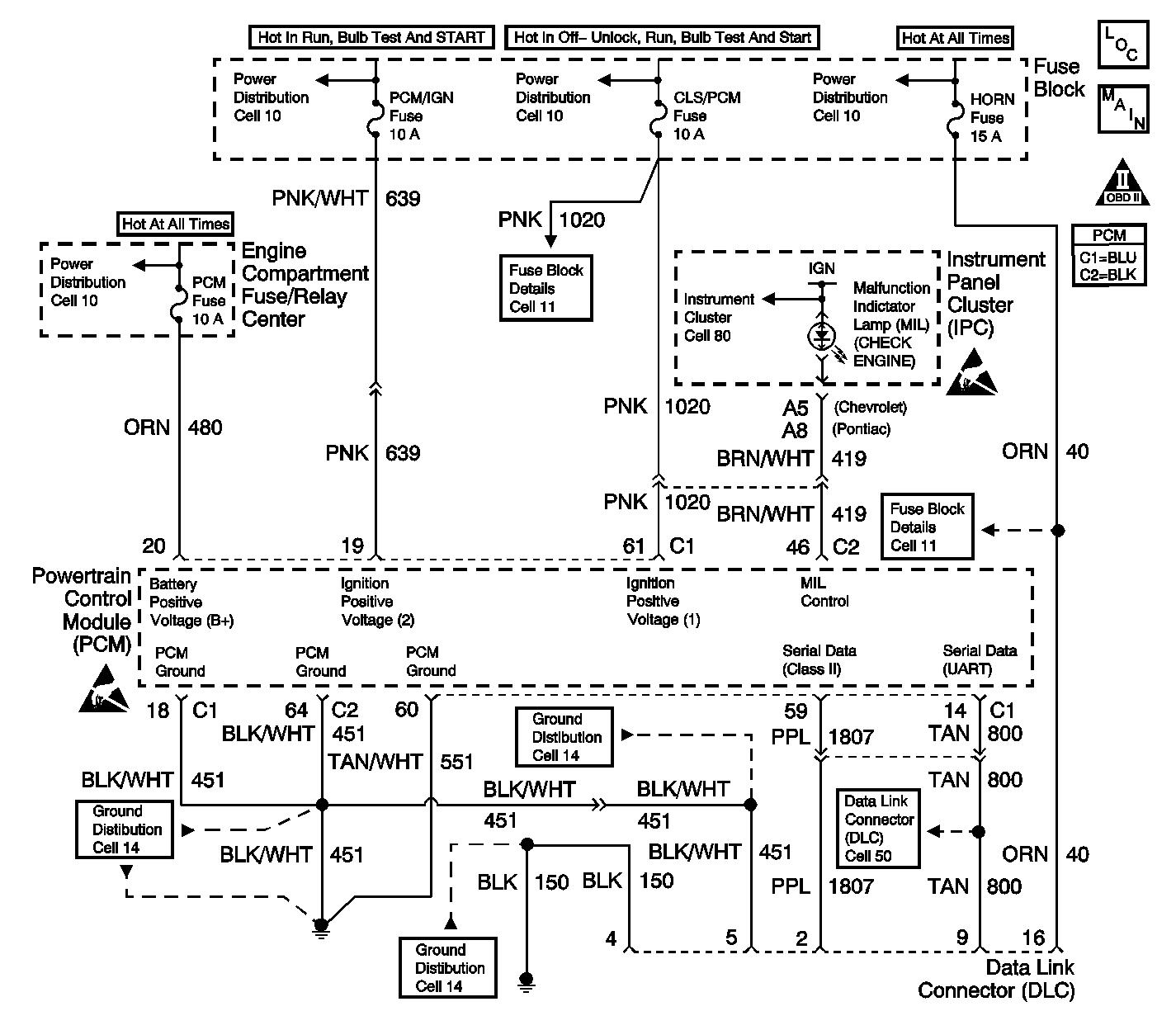
Circuit Description
When the ignition is turned ON, the malfunction indicator lamp (MIL) will momentarily flash ON then OFF and remain ON until the engine is running, if no diagnostic trouble codes (DTCs) are stored. The powertrain control module (PCM) controls the MIL by providing a ground path through the MIL control circuit to turn ON the MIL.
Diagnostic Aids
An open ignition #1 fuse will cause the entire cluster to be inoperative, and may set DTCs P1629 and U1016.
Check the battery and ignition 1 feed circuits for poor connections if the MIL is intermittent.
Any circuitry that is suspected as causing an intermittent complaint should be thoroughly checked for:
| • | Backed-out terminals |
| • | Improper mating |
| • | Broken locks |
| • | Properly formed or damaged terminals |
| • | For terminals to wiring connections |
| • | Physical damage to wiring harness |
Test Description
The numbers below refer to the step numbers on the Diagnostic Table.
-
The Powertrain OBD System Check prompts you to complete some of the basic checks and to store the freeze frame and failure records data on the scan tool, if applicable. This creates an electronic copy of the data captured when the malfunction occurred. The scan tool stores this data for later reference.
-
Connections that are suspected of being malfunctioning should be thoroughly checked as described in the diagnostic aids.
-
If the engine fails to start and the MIL is inoperative, then the malfunction can be isolated to one of the following items:
-
Probing the MIL circuit with a test light to ground simulates the PCMs control of the MIL. If the MIL illuminates, then the malfunction can be isolated to the control of the MIL or a poor electrical connection at the MIL terminal to the PCM. Electrical connections that are suspected of malfunctioning should be thoroughly checked as described in the diagnostic aids.
-
It takes very little resistance for the battery and the ignition 1 feed circuits to cause an intermittent condition. The battery and the ignition 1 feed circuits should also be checked for a poor electrical connection as described in diagnostic aids.
-
Reprogram the replacement PCM and perform the crankshaft position system variation learn procedure. Refer to PCM Replacement/Programming and CKP System Variation Learn Procedure .
Before replacing the PCM, check for the following condition(s):
-
A shorted MIL circuit can be diagnosed with a scan tool. Refer to Powertrain Control Module Outputs Diagnosis 2.4L Powertrain Control Module Outputs Diagnosis 2.2L .
-
An open MIL circuit can be diagnosed with a scan tool. Refer to Powertrain Control Module Outputs Diagnosis 2.4L Powertrain Control Module Outputs Diagnosis 2.2L .
-
For IPC replacement procedures, refer to Instrument Cluster Replacement in Instrument Panel, Gages and Console.
-
The PCM grounds will only cause a problem if all of the grounds are not making a good connection. If the PCM ground problem is suspected, the most probable place to check is where all of the grounds meet, at the engine block. Connections that are suspected of malfunctioning should be thoroughly checked as described in the diagnostic aids.
-
If no malfunctions are present at this point and no DTCs were set, refer to the diagnostic aids for additional checks and information.
| • | Open PCM ignition feed 1 circuit |
| • | Open battery feed circuit |
| • | Poor ground at the engine block |
| • | Malfunctioning PCM |
| • | Backed out terminals |
| • | Improper mating |
| • | Broken locks |
| • | Improperly formed or damaged terminals |
| • | Poor terminals to wiring connections |
| • | Physical damaged to the wiring harness |
Step | Action | Value(s) | Yes | No | ||||||||
|---|---|---|---|---|---|---|---|---|---|---|---|---|
Did you perform the Powertrain On-Board Diagnostic (OBD) System Check? | -- | Go to Powertrain On Board Diagnostic (OBD) System Check for 2.4L or Powertrain On Board Diagnostic (OBD) System Check for 2.2L | ||||||||||
2 | Turn ON the ignition switch leaving the engine OFF. Is the MIL ON? | -- | ||||||||||
Was a repair necessary? | -- | |||||||||||
Attempt to start the engine. Does the engine start? | -- | |||||||||||
5 |
Is the action complete? | -- | -- | |||||||||
Does the MIL illuminate? | -- | |||||||||||
7 |
Are the fuses OK? | -- | ||||||||||
Was a repair necessary? | -- | |||||||||||
9 | Did the test light illuminate? | -- | ||||||||||
10 |
Does the test light illuminate? | -- | ||||||||||
11 |
Is the action complete? | -- | -- | |||||||||
Is the action complete? | -- | -- | ||||||||||
Repair the short to voltage in the MIL control circuit. Wiring Repairs in Wiring Systems. Is the action complete? | -- | -- | ||||||||||
Was a repair necessary? | -- | |||||||||||
15 |
Does the test light illuminate? | -- | ||||||||||
16 | Repair open battery feed circuit. Refer to Wiring Repairs in Wiring Systems. Is the action complete? | -- | -- | |||||||||
17 |
Was a repair necessary? | -- | ||||||||||
18 |
Was a repair necessary? | -- | ||||||||||
19 | Repair the open in the PCM battery feed circuit. Refer to Wiring Repairs in Wiring Systems. Is the action complete? | -- | -- | |||||||||
Replace the IPC. Refer to Instrument Cluster Replacement in Instrument Panel, Gages and Console. Is the action complete? | -- | -- | ||||||||||
Was a repair necessary? | -- | |||||||||||
Does the scan tool display any DTCs that you have not diagnosed? | -- | Go to the applicable DTC table | System OK, Go to Diagnostic Aids |
